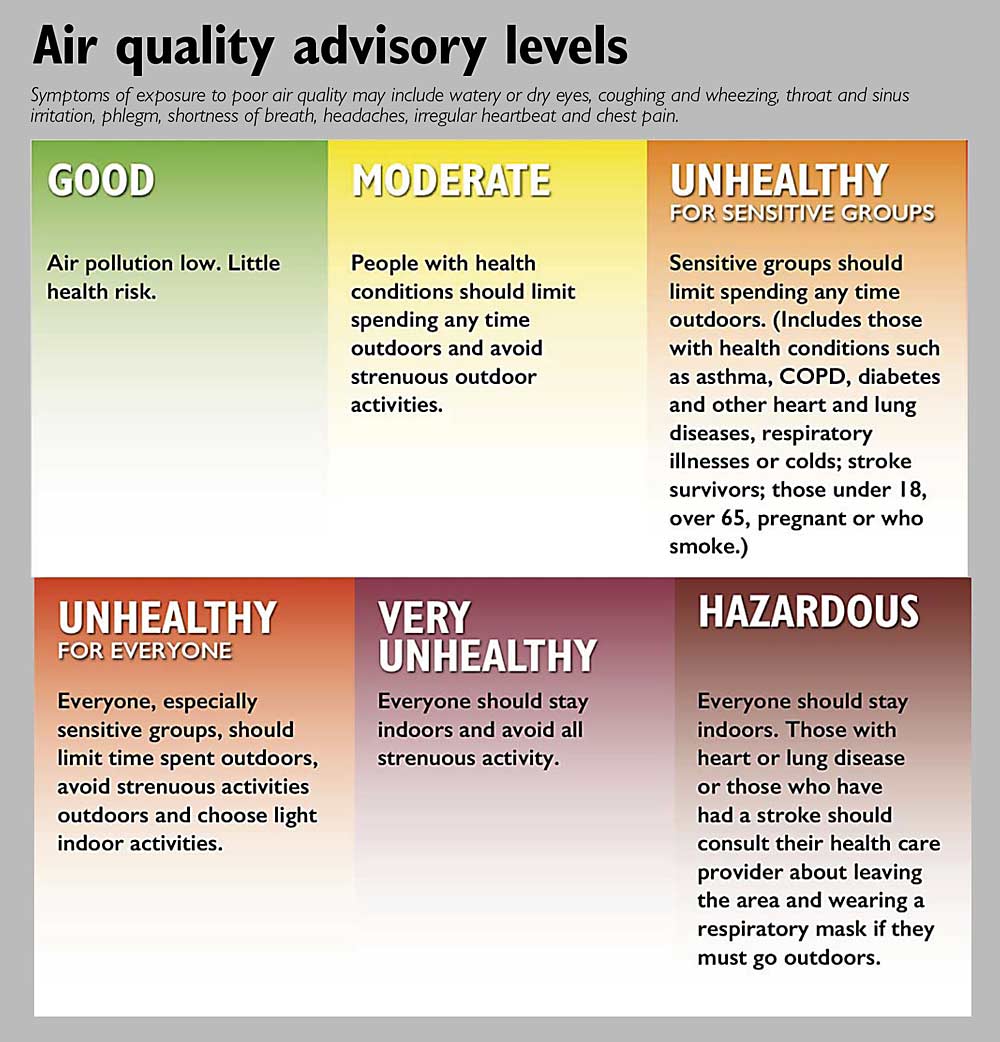September 2020 update: The EPA has created air quality mobile applications to help monitor conditions and can be downloaded at the Apple App Store and at the Google Play store. The story below is from our May 1, 2019, issue.

In recent years, late summer in the Pacific Northwest has meant hazy, smoke-filled skies from wildfires raging near or far. On the worst days, the pollution poses a health risk to those with sensitive health conditions, as well as those working outside, and anyone who employs farmworkers needs to pay close attention to the air quality index and take steps to protect employees’ health.
“This is serious,” said Washington State University tree fruit extension specialist Karen Lewis. “More years than not in the last five years, we have had hazardous days. So, let’s make plans for that.”
Lewis presented strategies and resources for handling the health concerns posed by smoke and heat at the Cherry Institute in Yakima, Washington, in January. While record-setting pollution levels grabbed headlines last August, she said that it’s normal to only have a few days of dangerous air quality during a smoky spell that can stretch for weeks.
Symptoms from exposure include coughing or wheezing, throat and sinus irritation, headaches, shortness of breath and chest pain, and if symptoms continue or worsen, medical attention is in order, according to the Washington State Department of Health.
Officials measure the levels of particulate pollution from car exhaust, wildfire smoke and other sources on a color-coded, six-step scale known as the air quality index: good, moderate, unhealthy for sensitive groups, unhealthy for everyone, very unhealthy and hazardous. Sensitive people include those with heart or lung conditions, those who are pregnant, young children and the elderly.
For most workers who don’t fall into that category, “it’s not three weeks that you need to mitigate this, it’s several days plus,” Lewis said, citing the number of days that hit the very unhealthy or hazardous classification in recent summers. Mitigation options include letting workers opt out of working, providing respirators, moving rest breaks to well-ventilated spaces with cool, clean air, changing the work schedule or calling off work entirely until air quality improves.
So where do you find that air quality index?
Lewis recommends the Washington smoke blog, found at wasmoke.blogspot.com, a collaboration of state, local, tribal and federal agencies with air quality jurisdiction and monitors. In addition to the day’s air conditions, the blog has links to resources about smoke exposure, safety and precautions.

The Washington Department of Health suggests that workers who must be outside during unhealthy conditions use respirator masks for protection. Look for N95 or N100 masks with two straps, not paper dust masks or surgical masks. The mask needs to fit snugly over the nose and chin — no beards — to work properly.
“If you don’t teach people how to wear and fit them, you might as well not tell people to wear them,” Lewis said.
Wearing these masks, however, increases the effort of breathing, so using a mask all day or while doing strenuous work can also stress the respiratory system, Lewis cautioned. That means workers will need extra rest breaks, somewhere they can breathe cool, clean air, mask-free. If the standard break room doesn’t have air conditioning or good ventilation, seek out another option.
It’s also important to remember that employees might have a child with asthma at home or a parent with a chronic lung disease for whom the air pollution could be life-threatening.
“Understand these are tough days and tough weeks for everybody,” Lewis recommended. “People are irritable; they are worried about family at home.”
Growers can reach out to their local public health departments if they need help developing mitigation strategies or conducting a training in Spanish, she added. As for developing systems to allow workers to opt out of field work for a few days when pollution is high, growers should work with their HR and legal teams to make sure the plan to protect worker health doesn’t raise other liability concerns.
And when the index starts to turn red or purple, consider just canceling work for a day or two, Lewis said.
“If it’s unsafe for your kids to be outside, it’s unsafe for your workers,” she said. “When it’s hazardous for everyone, it’s hazardous for everyone.” •
—by Kate Prengaman
Resources:
The national resource for the air quality index updates is AirNow.gov, run by the federal government.Oregon and Idaho have dedicated wildfire smoke websites similar to Washington’s wasmoke.blogspot.com, found at Oregonsmoke.blogspot.com, and IDsmoke.blogspot.com, respectively.
Several regional air pollution management districts in California also provide local advisories.







Leave A Comment